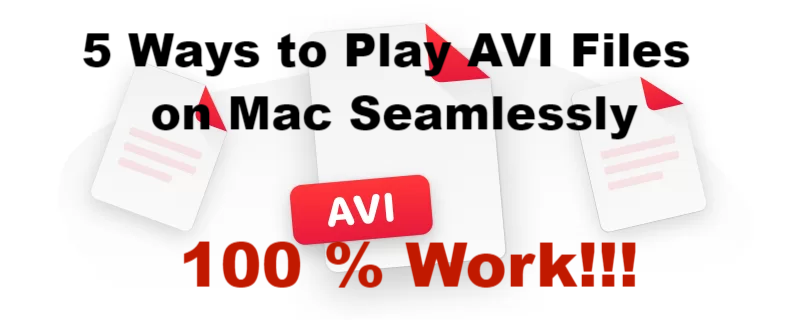Tech
5 Ways to Play AVI Files on Mac Quickly and Easily
Ways to Play AVI files on Mac Seamlessly [100% Work]
Do you know any effective methods to open AVI on Mac? AVI is a popular multimedia container format commonly used for storing audio and video data. However, Mac operating systems may require additional codecs or software to play them. If you are wondering how to play AVI files on Mac, Let’s dive in and play it without playback today.
Why Can’t I Play AVI Files on Mac?
The inability to play AVI files on Mac could be due to several reasons.Here are a few potential causes:
- Lack of appropriate video codec: If your Mac lacks the necessary codec to decode the video, you won’t be able to play the file.
- Outdated media player: If you are using a media player that hasn’t been updated in a while, it might not support certain video codecs or file formats.
- Incompatible software: Some third-party media players may have limitations in terms of the file formats they can handle.
- Corrupted AVI file: If the AVI file itself is corrupted or incomplete, it may not play correctly on any system.
- Software conflicts: Conflicts between different software applications or codecs installed on your Mac could cause issues with playing AVI files.
How to Play AVI Files on Mac
Fix 1:Repair Corrupted Files to Open AVI on Mac
As mentioned previously, if you’re unable to play AVI videos on Mac, it’s important to check if the file is damaged or corrupted. If it’s damaged, corruption issues are typically related to the AVI file index rather than the video content itself.
However, you don’t need to worry. There are third-party software solutions available to fix this, such as the 4DDiG Mac Data Recovery software. This software can help recover and repair corrupted AVI files by repairing the file index.
The 4DDiG Mac Data Recovery software offers the following features:
- supports recovery of data from over 1000+ different file types, including videos, photos, documents, and more.
- Recover data from both internal and external devices such as SD cards, USB drives, and more.
- Recover data from various scenarios like accidental deletion, formatting, virus attacks, system crashes, and more.
- Users can preview recovered videos before saving them.
To recover a corrupted, damaged, or broken AVI media file using the Tenorshare 4DDiG software, follow the steps below:
Step 1: Download, install, and launch the Tenorshare 4DDiG software. Choose the location where the corrupted AVI files were stored and click on the “Scan” button.
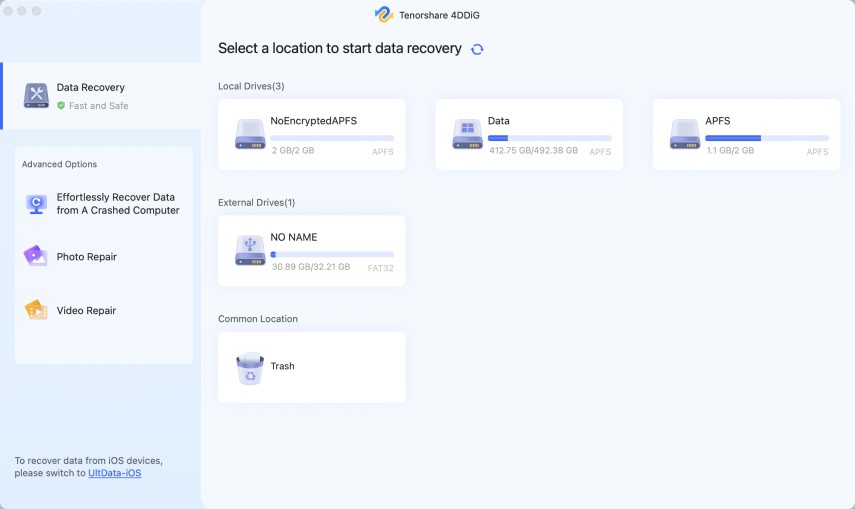
Step 2: Wait for 4DDiG to complete the scan and identify all the corrupted AVI files. You can preview each file to find the playable AVI video.
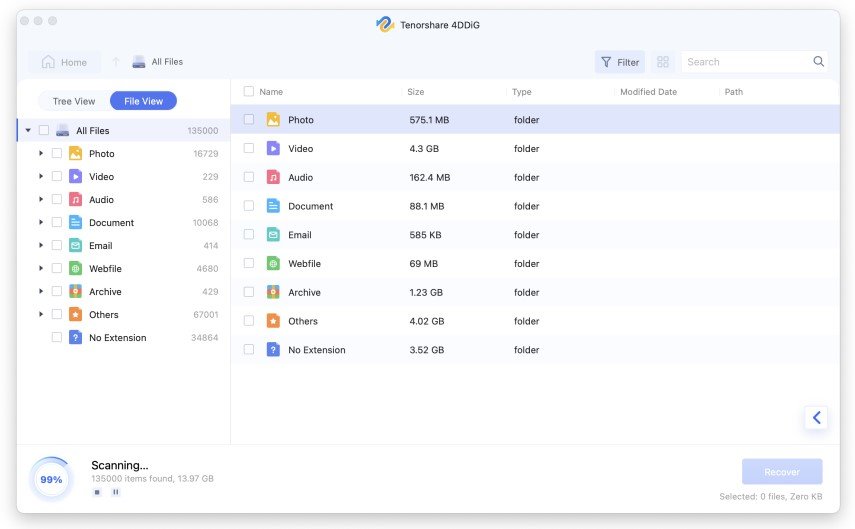
Step 3: After previewing, select the playable AVI video files and click on the “Recover” button. On the next window, choose a different location to store the recovered files, avoiding the same location where they were originally stored.
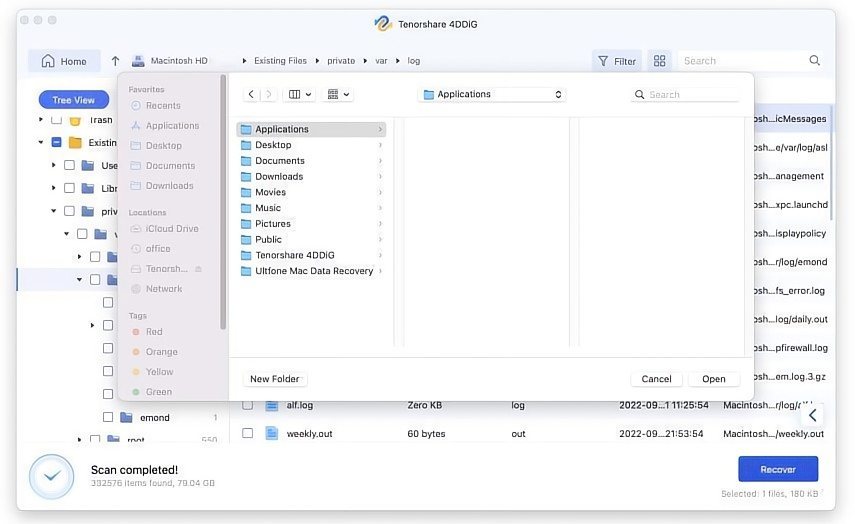
On the other hand, if you want to know about how to recover deleted files after emptying trash on Mac, you could check this one
Fix 2:How to Play AVI Files on Mac with QuickTime
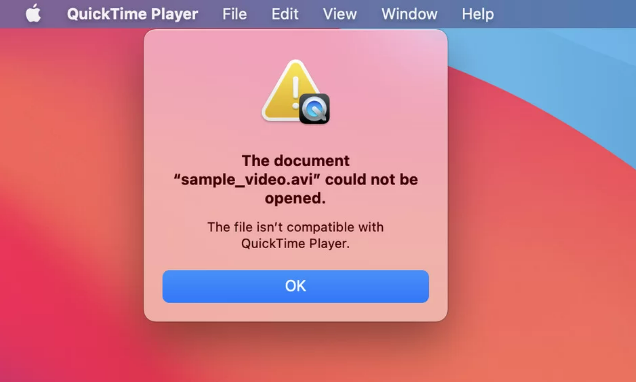
2.2.1:Play AVI Files on Mac Using Codec
If you can’t play AVI files on your Mac, it’s likely due to the absence of a required codec. To resolve this, simply select a suitable codec and install it in your video player.
One highly recommended decoder is 3ivx MPEG-4, which significantly enhances the functionality of your video player. This codec supports all AVI file formats, allowing seamless playback on QuickTime and other media players on your Mac. With 3ivx MPEG-4, you can easily enjoy AVI files without the need for third-party tools or file conversions.
Moreover, the 3ivx decoder is capable of playing various file formats including MOV, MP4, M4A, and 3GP, featuring MPEG-4 video and MPEG-4 AAC audio. It is also compatible with MPEG-4 variants such as DivX 3, MPEG-4, and Xvid. You can download the codec by visiting their official website.
2.2.2Open AVI on Mac via Plugin
To play AVI files on Mac swiftly and effectively, utilizing a plugin or add-on is one of the most convenient solutions. QuickTime Perian, a free open-source component, was widely used to enable QuickTime to play unsupported video formats on MacOS, including AVI, Xvid, and DivX. Unfortunately, the Perian add-on is no longer available. However, the development team recommends NicePlayer or MPlayer OS X as a suitable alternative.
Fix 3:Download a Reputable AVI Player for Mac
While QuickTime is a powerful video player included in Apple’s MacOS, it does not support the AVI file format. If you can’t open AVI on Mac, it’s advisable to consider using a third-party AVI player for Mac.
When choosing a third-party video player, it’s essential to prioritize safety. Some players may pose security risks or impact your device’s performance, including audio quality. To simplify your decision-making, here are some of the best and most reliable video players for your Mac:
- Elmedia Player
- VLC Player
- 5K Player
- Just Play
- Omni Player
These video players support the AVI file format and prioritize the safety of your data. You can install any of these players and easily play AVI files on your Mac.
Fix 4:convert AVI to mp4 on Mac
If you prefer not to use a third-party AVI player for Mac, another option is to convert AVI to MP4 on Mac. MP4 or MOV formats are natively supported by QuickTime, so by converting the file, you can ensure smooth playback without the need for additional software.
VLC is a free AVI converter for Mac and the straightforward process ensures effortless conversion of AVI to MP4 on Mac. Here are detail steps for how to convert AVI to mp4 on Mac:
Step 1: Visit the VLC website and download the Mac version of the VLC program. Once downloaded, install it on your Mac computer following the provided instructions.
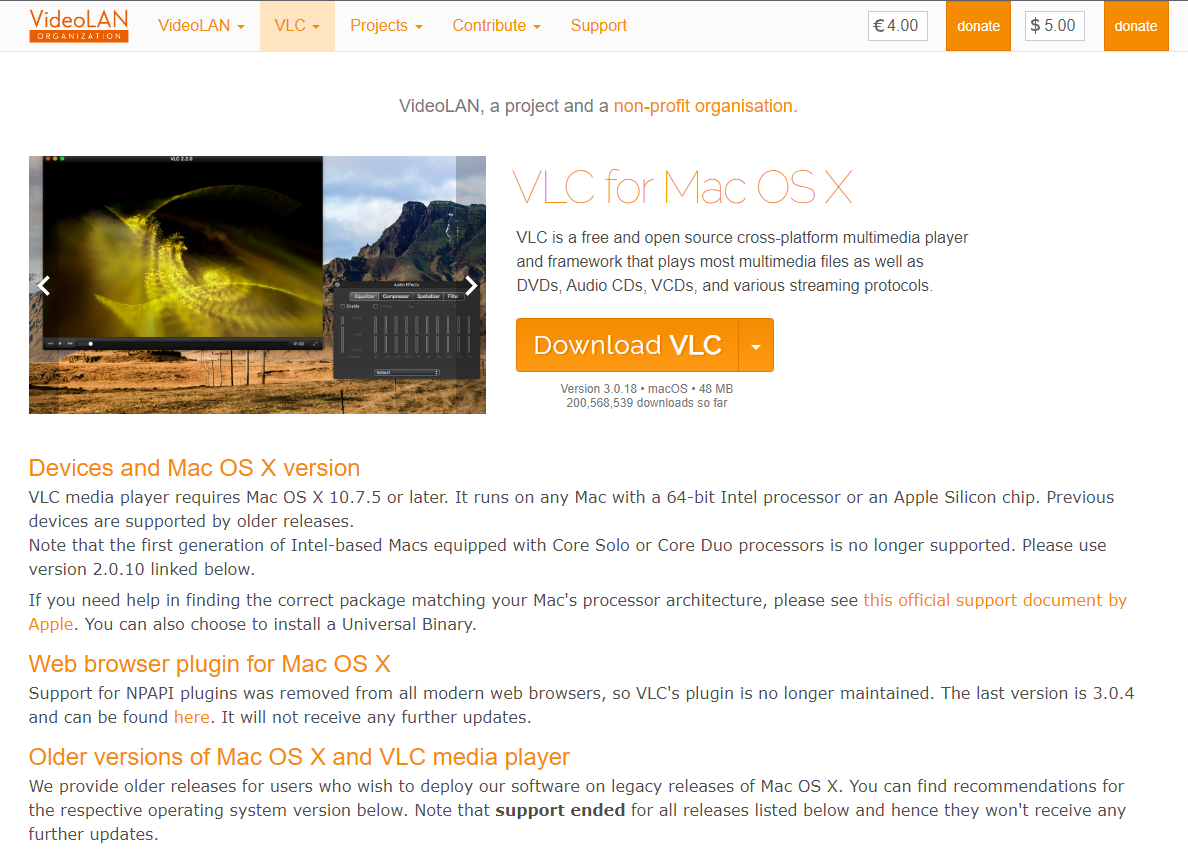
Step 2:Open VLC and navigate to the File menu. Click on the “Convert / Stream” button and you’ll find a “Drop media here” section at the top. You can either click on “Open media” to browse and select AVI files from your computer or directly drag and drop the AVI files from the Mac Finder into the program.
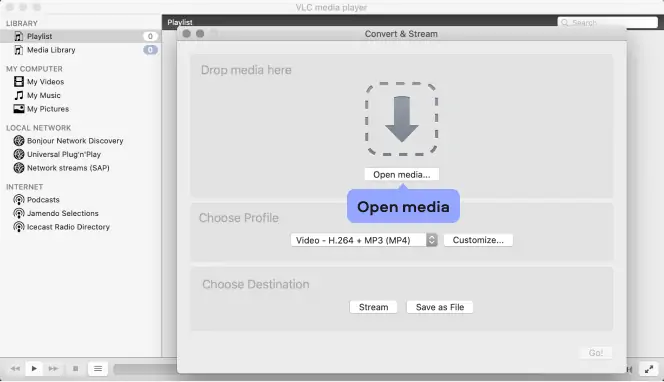
Step 3: Once you’ve added the AVI files to the converter, go to the “Choose Profile” tab. Here, you can select the desired format for conversion. For example, if you want to convert to MP4, choose “Video – H.264 + MP3 (MP4)”.
Step 4: After selecting the files and the desired conversion format, proceed to the “Choose Destination” tab. Then, click on the “Save as File” button to save the files.
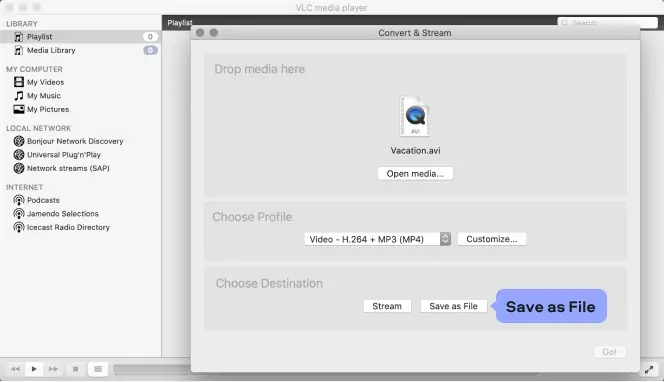
Finally, wait for the conversion process to complete, and you will play AVI files on Mac smoothly.
Part 4:Things Related to How to Play AVI Files on Mac
What are AVI Files?
AVI stands for Audio Video Interleave, and AVI files are a multimedia container format used to store audio and video data. They were introduced by Microsoft and are commonly used for video playback on Windows-based systems. Consequently, it can be a bit challenging to play AVI files on Mac.
What is a Codec?
A codec, short for “coder-decoder,” is a technology or algorithm used to compress and decompress audio and video data. It is responsible for encoding the data into a compact form for efficient storage or transmission and decoding it back into its original format for playback or editing.
When you want to open AVI files on a Mac, it’s necessary to download the specific codec used to encode the audio and video data within the AVI file.
Why Quicktime Can’t Play AVI Files on Mac?
By default, QuickTime on Mac does not support playing all types of AVI files due to codec compatibility issues. AVI files can be encoded using various codecs, and QuickTime only supports a limited number of codecs out of the box.
Therefore, when attempting to play AVI files in Mac, you may encounter issues such as missing audio or video, or the file may not open at all.
Conclusion
In summary, when you need to open and play AVI files on Mac, it is essential to ensure compatibility and ease of use. By utilizing the right tools and software, you can effortlessly open AVI on your Mac.
Whether you choose to install a reliable AVI player for Mac or convert AVI to the MP4 format for seamless playback, these methods provide effective solutions. However, if these AVI files are damaged or corrupted, you can rely on 4DDiG Mac Data Recovery to repair it effortlessly.

Tech
US: A Judge Mandates that Google Allow Competing App Stores to Access Android

(VOR News) – The ruling is that Google, the greatest technology firm in the world, is required to make its Android smartphone operating system available to merchants that supply applications that are in direct rivalry with Google’s. This decision was reached by a judge in the United States of America.
The Android Play store, which is owned and operated by Google, was found to be an example of an illegal monopoly arrangement by a jury in the state of California on Monday. The finding was reached by a jury. Monday is the day that this decision was come to.
An earlier federal judge ruled Google’s search engine illegal.
This finding, which came after that decision, has forced the company to suffer yet another setback. As a result of the corporation having already encountered its initial obstacle, this decision has been established. This particular decision was made by the judge during the month of August, when the month was in progress.
In light of the fact that the decision was made, what exactly does it mean that the choice was accepted?
In accordance with the verdict, Google is obligated to make it possible for users to download Android app stores that are offered by third-party competitors. For a period of three years, the corporation is prohibited from imposing restrictions on the usage of payment mechanisms that are integrated into the application.
In addition, it is important to keep in mind that Google does not possess the right to impose restrictions on the utilization of ways to make payments online.
Additionally, the verdict makes it unlawful for Google to give money to manufacturers of smartphones in order to preinstall its app store. Smartphone manufacturers are prohibited from doing so.
Furthermore, it prevents Google from the possibility of sharing the revenue that is generated by the Play store with other companies that are in the industry of delivering mobile applications.
In addition to this, the court has mandated the establishment of a technical committee that will be made up of three different people chosen at random.
The committee will be responsible for monitoring the implementation of the reforms and finding solutions to any disagreements that may occur as a consequence of the implementation of the reforms while they are being implemented. This task will fall under the committee’s purview so that it may fulfill its duties.
However, certain components were allowed to be put into action until July 1st, despite the fact that the judge’s statement suggested that the ruling would take effect on November 1st. The statement was the basis for the ruling, which ultimately became effective.
Particularly, I wanted to know what Google’s reaction would be.
There is a fact that Google does not adhere to this directive, which has been brought to their attention. This document argued that the alterations that the judge had ordered to be made would “cause a range of unintended consequences that will harm American consumers, developers, and device makers.”
The judge had ordered the modifications to be implemented. The alterations were to be carried out as indicated by the judge’s ruling. The judge made it clear that he expected these revisions to be carried out in accordance with his guidance.
The company’s regulatory affairs vice president, Lee-Anne Mulholland, provided the following statement: “We look forward to continuing to make our case on appeal, and we will continue to advocate for what is best for developers, device manufacturers, and the billions of Android users around the world.”
On average, over seventy percent of the total market for smartphones and other mobile devices is comprised of mobile devices that are powered by the Android operating system. Both smartphones and other small mobile devices are included in this category.
In the event that the Play app store continues to be shown on the home page and that other Google applications are pre-installed prior to the installation of the Android application, smartphone manufacturers are entitled to install the Android application at no cost at their discretion.
Additionally, the Android application can be installed on devices that are manufactured for smartphones.
SOURCE: DWN
SEE ALSO:
Over The Planned “Link Tax” Bill, Google Threatens to Remove NZ News Links.
Tech
WhatsApp Now Features a “Mention” Tool for Status Updates and Stories.

(VOR News) – Those who use WhatsApp now have the ability to mention other people in their stories or status updates as a consequence of a feature that was only recently enabled on the platform.
Previous to this point, this capability was not available. It wasn’t until quite recently that this capability became available to the public.
According to the information that was provided by the company, users now have the opportunity to tag close friends in their stories, and the person who is mentioned will have the option to go back and re-share an earlier version of that story. This information was provided by the company. The corporation was kind enough to reveal this information to us.
Because of a new feature that has been added to the WhatsApp app, users now have the opportunity to like individual stories and status updates.
This capability was previously unavailable to WhatsApp users.
A significant amount of progress has been made in this context. Alternative readers now have the chance to “like” a work, which is comparable to liking a post on Facebook. This feature was introduced in recent years. When compared to the past, this is a tremendous shift.
At one point in time, viewers were only permitted to observe the total number of views that a particular story had gotten. These restrictions were eliminated in later versions of the software.
Additionally, it is essential that the likes and reactions to a story be kept anonymous during the entire process. One of the factors that contributes to the general mystery that surrounds this characteristic is the fact that this is one of the elements.
The person who brought it to the attention of others is the only person who will be able to judge who enjoyed it and who did not care about it. These individuals will be able to make this determination.
A notification will be issued to the individual who was referenced earlier in the sentence and who was named in the story or status update that was discussed. A notification of this nature will be sent to the individual via WhatsApp.
This message will be sent to the user in question whenever that person makes a reference to another person while they are in the process of elaborating on a narrative or updating their status. You will receive a notification alerting you that you have been tagged in the narrative.
This notification will be delivered to the person who receives this message. In addition, students will be provided with the opportunity to re-share the tale for themselves.
It is important to note that if the names of individuals who have been referenced in a narrative or a status update are included in any of these, then the names of those individuals will not be accessible to any third party through any of these. In light of the fact that the identities of those individuals will be concealed from public disclosure, this is the condition that will be required.
While WhatsApp recently made the announcement that it will be incorporating this functionality, it is highly likely that not all users will have access to it at the same time.
This is despite the fact that WhatsApp recently made this announcement.
Despite the fact that WhatsApp has only recently made a public announcement that it will move forward with the deployment, this is the situation that has presented itself.
As soon as a short period of time has elapsed, access will be made available to each and every person on the entire world.
Additionally, WhatsApp has hinted that new functionalities might be introduced to the status and updates tab in the future months.
The purpose of these capabilities is to provide users with assistance in maintaining healthy connections with the individuals who play a vital role in their living experiences. This is done in order to give users with support in maintaining close relationships with the folks who are the subject of the inquiry.
It is with the purpose of supporting users in successfully keeping close ties with the individuals in question that this step is taken.
SOURCE: DN
SEE ALSO:
Over The Planned “Link Tax” Bill, Google Threatens to Remove NZ News Links.
Accenture and NVIDIA Collaborate to Enhance AI Implementation.
Tech
Over The Planned “Link Tax” Bill, Google Threatens to Remove NZ News Links.

(VOR News) – Google has sent a strong message to the New Zealand government, threatening to stop boosting local news content should the Fair Digital News Bargaining Bill become law.
The law, put up by the Labour government and backed by the coalition in power at the moment, mandates that digital companies such as Google pay back news organizations for links to their material.
News publishers, on the other hand, charge the tech giant with “corporate bullying.”
Google says this measure may have unanticipated effects.
Google New Zealand’s country director, Caroline Rainsford, voiced her worries that the law, which is being referred to as a “link tax,” is not doing enough to support the media industry in New Zealand right now.
She underlined that Google would have to make major adjustments if the previously mentioned law were to pass, including cutting off links to news articles from its Search, News, and Discover platforms and cutting off financial ties with regional publications.
According to Rainsford, similar legislation has been proposed and approved in other nations including Australia and Canada, but it has not been proven to be effective there and breaches the principles of the open web.
She drew attention to the fact that smaller media outlets will be most negatively impacted, which will limit their capacity to reach prospective audiences.
Google says its alternative options will protect smaller, local media from negative effects.
Conversely, it conveys apprehension regarding the possible fiscal obligations and vagueness of the legislation, which it feels generates an intolerable level of ambiguity for enterprises functioning within New Zealand.
The New Zealand News Publishers Association (NPA) has reacted to Google’s warnings by alleging that the internet behemoth is using coercive tactics.
They specifically contend that the need for regulation stems from the market distortion that Google and other tech giants have created, which has fueled their expansion into some of the most significant corporations in global history.
The legislation aims to create a more equal framework that media businesses can use to negotiate commercial relationships with technological platforms that profit from their content.
New Zealand Media Editors CEO Michael Boggs stated that he was in favor of the bill, citing the fact that Google now makes a substantial profit from material created by regional publications.
He also emphasized that the use of artificial intelligence by Google—which frequently makes references to news articles without giving credit to the original sources—highlights the significance of enacting legislation.
Paul Goldsmith, the Minister of Media and Communications, has stated that the government is now evaluating various viewpoints and is still in the consultation phase.
He stated that the government and Google have been having continuous talks and will keep up these ongoing discussions.
However, not all political parties accept the validity of the Act.
The ACT Party’s leader, David Seymour, has voiced his displeasure of the proposal, saying that Google is a game the government is “playing chicken” with. He threatened the smaller media companies, saying that they would suffer from worse search engine rankings if the internet giant followed through on its promises.
Seymour contended that it is not the government’s responsibility to shield companies from shifts in the market brought about by consumer preferences.
The things that have happened in other nations are similar to what has happened in New Zealand.
Google has agreements with a number of Australian media firms that are in compliance with its News Media Bargaining Code. These agreements contain provisions that permit an annual cancellation of these agreements.
Due to the government’s decision to exempt Google from the Online News Act, the company has committed to supporting news dissemination by contributing annually to the Canadian journalistic community.
The New Zealand measure is consistent with global approaches aimed at regulating the relationships that exist between technology corporations and media organizations.
It’s hard to say what will happen with the Fair Digital News Bargaining Bill as the discussion goes on. Google and the New Zealand media landscape are preparing for what might be a protracted legal battle.
SOURCE: TET
SEE ALSO:
Accenture and NVIDIA Collaborate to Enhance AI Implementation.
-

 News3 years ago
News3 years agoLet’s Know About Ultra High Net Worth Individual
-
Entertainment2 years ago
Mabelle Prior: The Voice of Hope, Resilience, and Diversity Inspiring Generations
-

 Health3 years ago
Health3 years agoHow Much Ivermectin Should You Take?
-

 Tech2 years ago
Tech2 years agoTop Forex Brokers of 2023: Reviews and Analysis for Successful Trading
-

 Lifestyles3 years ago
Lifestyles3 years agoAries Soulmate Signs
-

 Movies2 years ago
Movies2 years agoWhat Should I Do If Disney Plus Keeps Logging Me Out of TV?
-

 Health3 years ago
Health3 years agoCan I Buy Ivermectin Without A Prescription in the USA?
-

 Learning2 years ago
Learning2 years agoVirtual Numbers: What Are They For?
